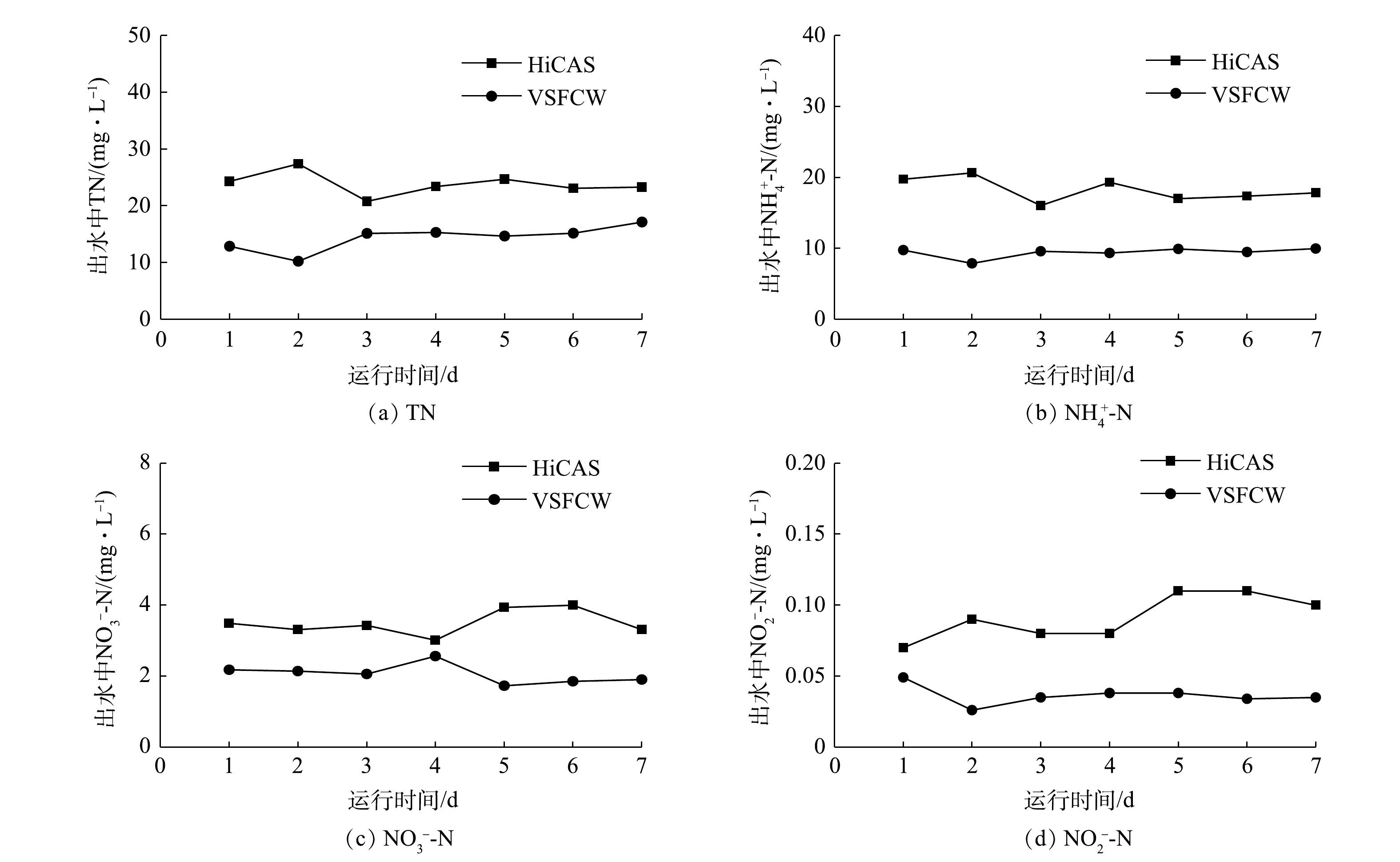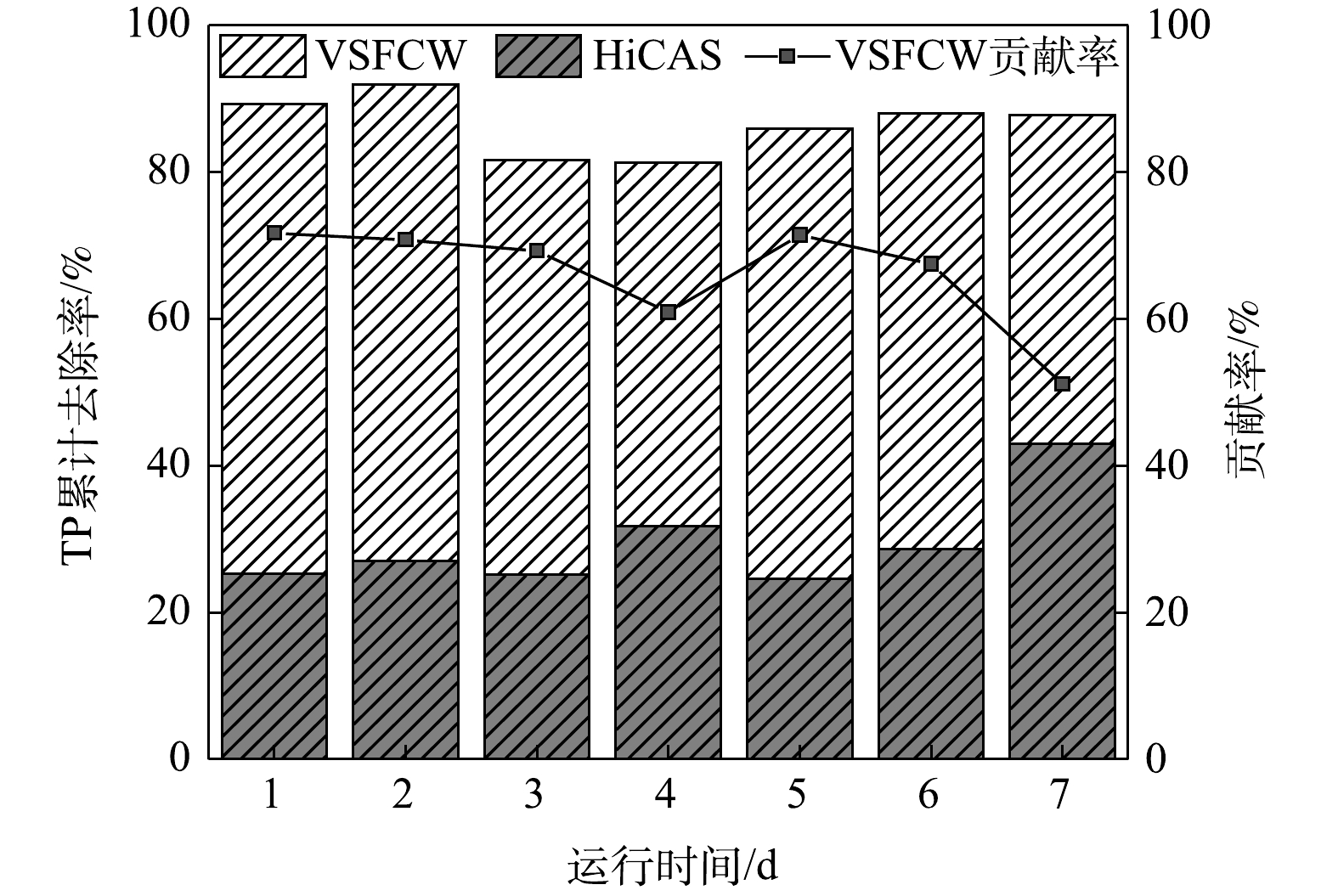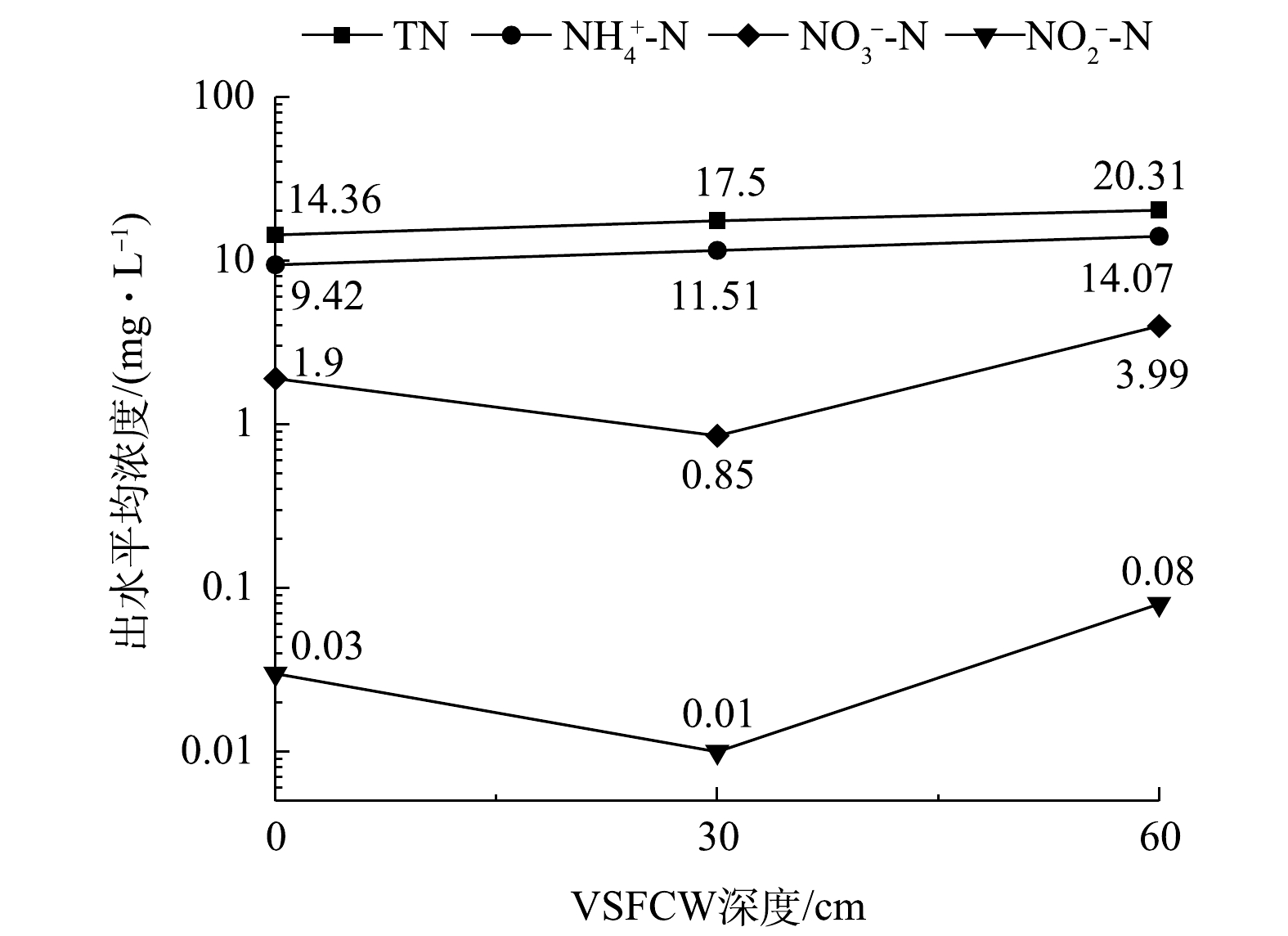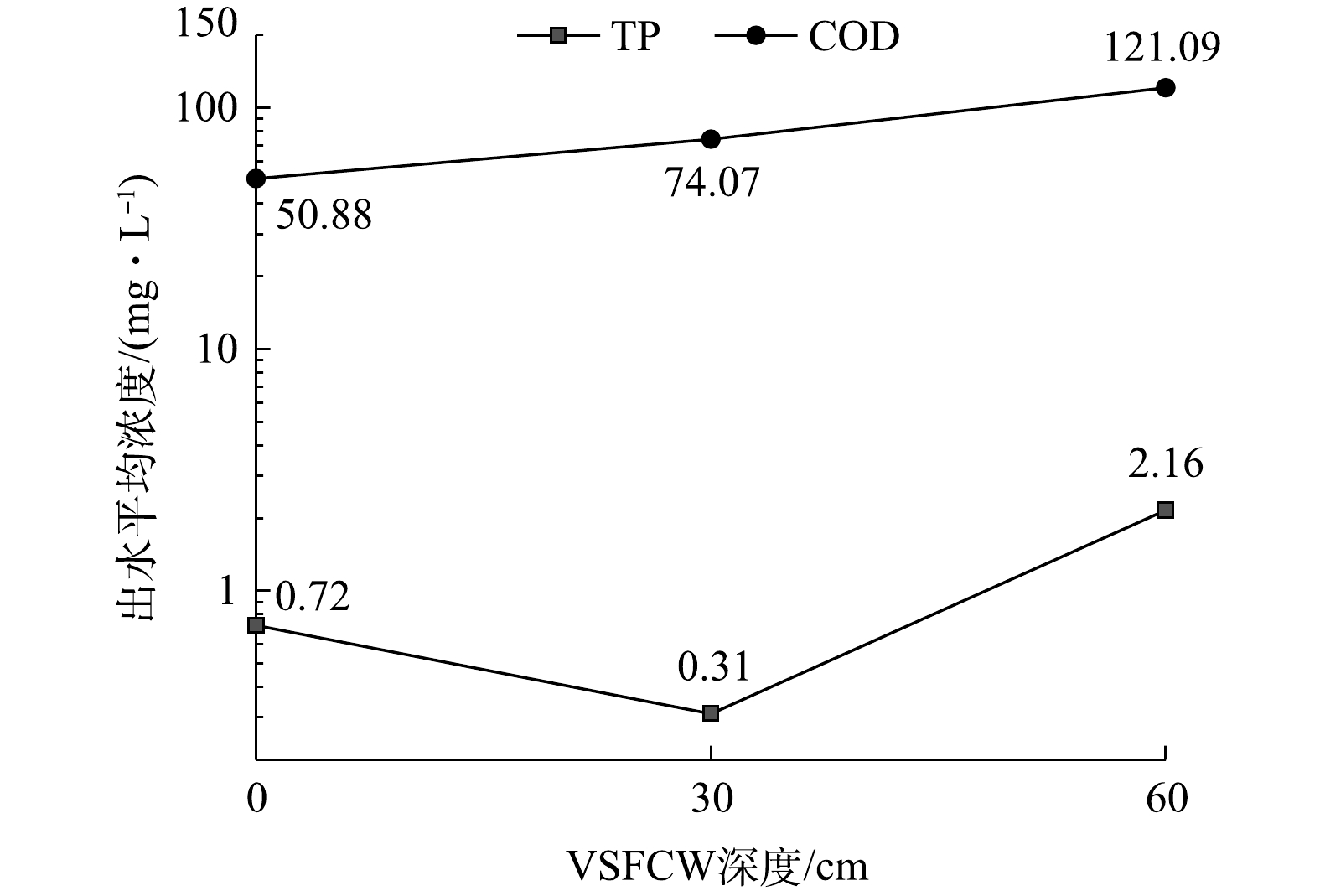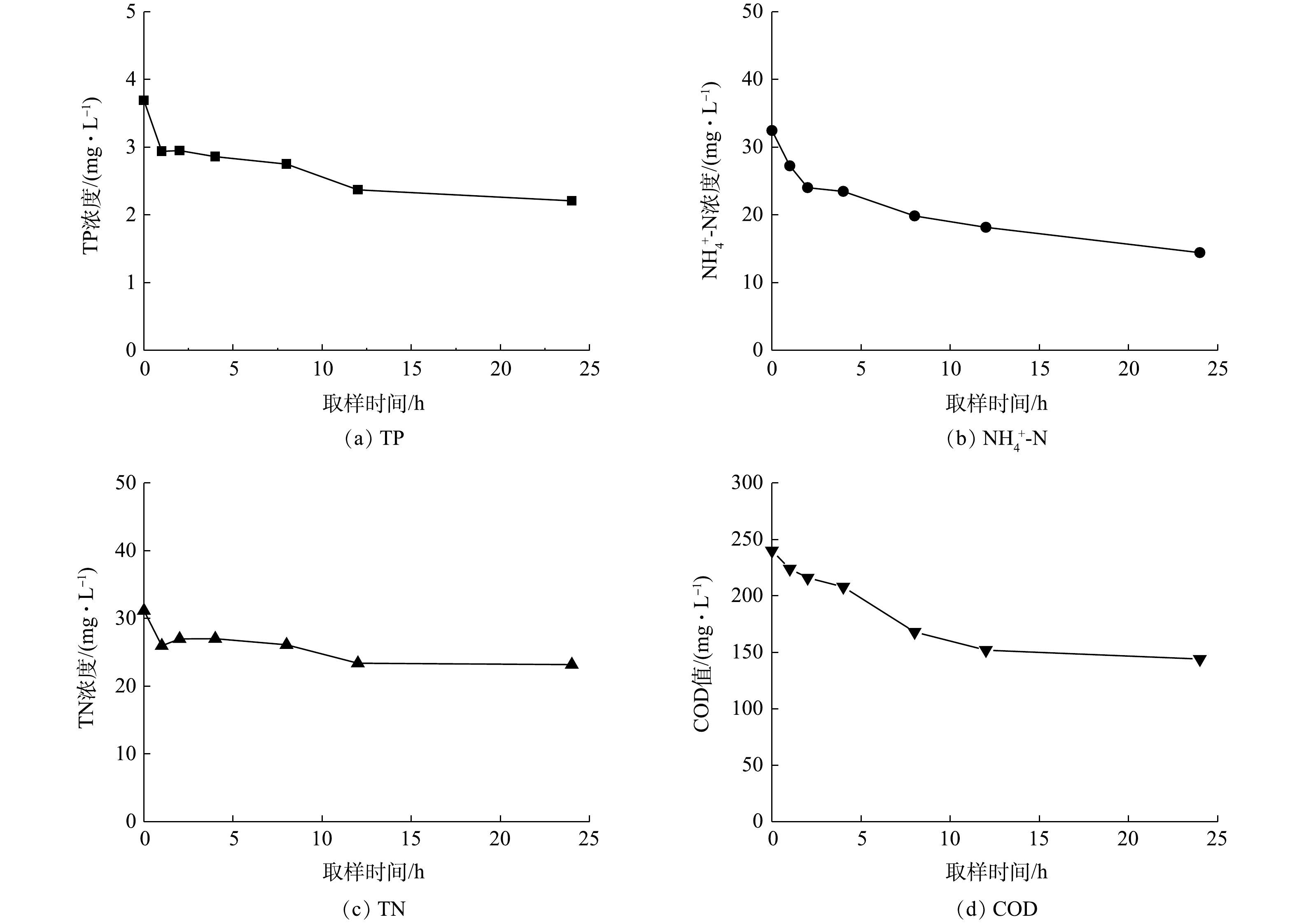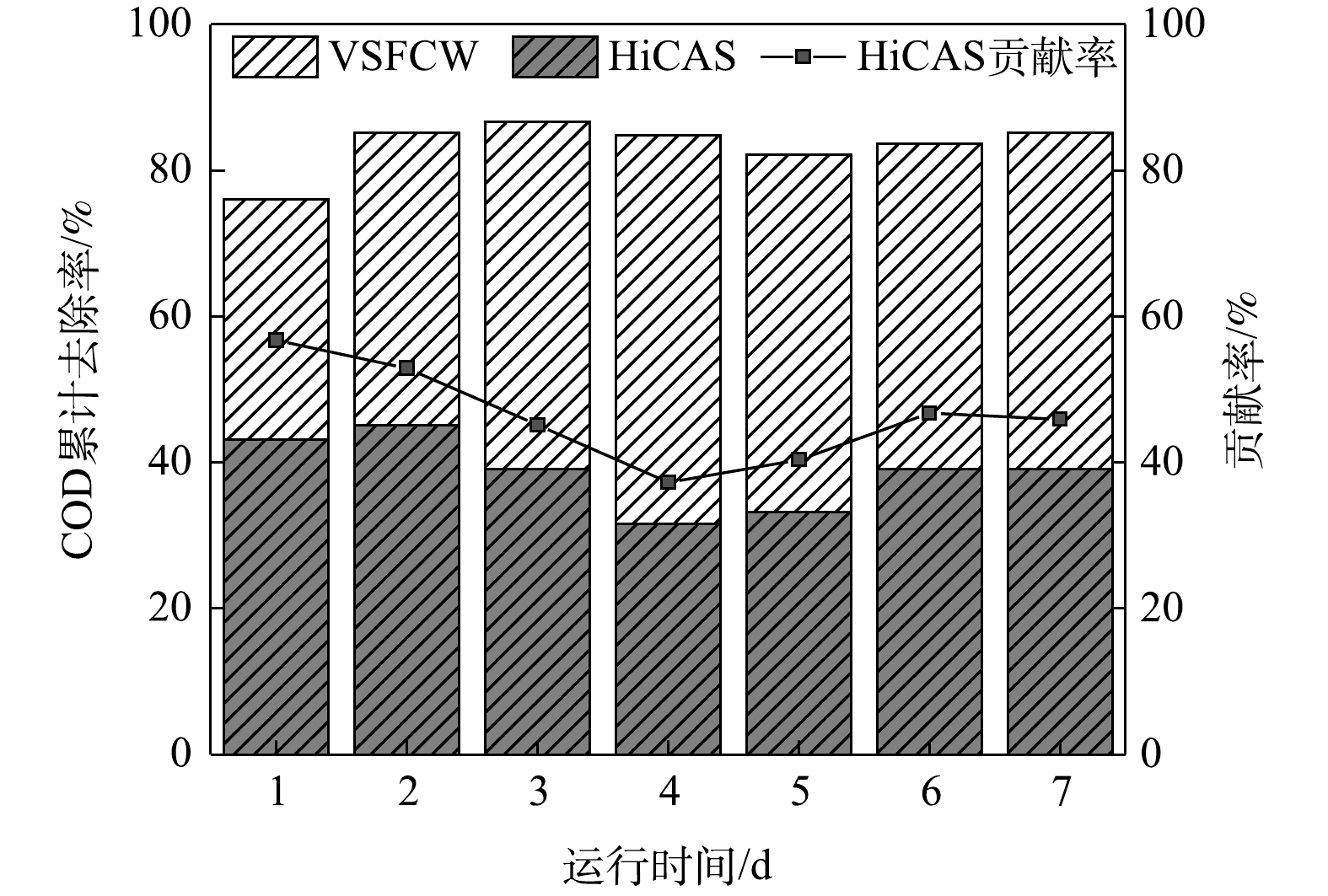-
废水资源化处理已经成为国际学术界关注的热点,并被列入联合国可持续发展目标(SDGs)[1]。生活污水中蕴含着大量的资源,其中的热能至少超过了污水处理厂运行电力的9倍[2],氮、磷资源也非常丰富。比利时皇家科学院计算发现,1 t污水可以回收的水资源、有机肥、甲烷、氮、磷等物质的价值在0.41欧元左右,具有重要的经济、生态双重效益[3]。传统的污水处理方法主要以去除污染物质为目标,难以将这些资源回收利用,造成资源浪费。2012年,我国污水排放量为6.85×1010 t,相当于9.61×109 m3甲烷、3.37×106 t氮源、7.17×105 t磷源、1.21×106 t硫源被浪费[4]。此外,传统的污水处理方法还存在着能源损耗大、存在二次污染风险等缺陷。如常规活性污泥法(CAS)的耗能约在0.6 kWh·m−3,其中曝气池耗能就占总能耗的50%左右[5]。美国污水处理厂每年能耗约为1.50×1010 W,占国家总电耗的3.4%,是美国的第3能耗大户;另外,美国在2010—2015年,污水有机物降解产生的CO2高达6×108 t,预计到2050年可能增至10×108 t[6]。因此,污水资源化处理方法的探索已成为未来污水处理技术的首要任务之一,也是环境工程领域亟待攻克的重要课题。
将单纯的污水处理工艺转变为有目的性的资源回收工艺,采用单一的污水处理设备几乎无法实现。目前国内外普遍应用的A/O、AA/O、SBR以及MBR等工艺均是将去污作为唯一或首要目的,污水处理过程中由于有机碳矿化和微生物的生物降解,导致剩余污泥产量少或质量低,污水中蕴含的能量无法回收,因此,传统的污水生物处理工艺难以成为可持续发展技术[2, 7-9]。为实现污水资源化,亟需寻找一种可以实现净能量和资源回收的污水处理手段[10]。厌氧消化产甲烷可将废水中有机物转化为可利用的能量,为达到最大程度回收,应在污水处理过程中避免有机物氧化,从而获得高浓度的优质污泥(更具消化特性)。研究人员[11]开发的高效活性污泥(HiCAS)工艺在去除有机物的同时,能产生大量的优质污泥,其作为一个成功的预浓缩技术受到广泛关注。HiCAS具有高的食物微生物比、低的污泥停留时间(SRT)(一般0.1~2 d)以及较短的HRT,运行负荷高,由微生物内源呼吸引起的生物量损失可降到最小,使水中可溶性有机物最大程度地浓缩、转移到污泥中,产生大量的优质污泥[7, 12-13],因此,该工艺能源回收潜力大,已成功应用于奥地利斯特拉斯以及荷兰鹿特丹的污水处理厂[14-15]。尽管HiCAS工艺具有较强的能源回收潜力,但污水经过该工艺处理后难以直接达到排放标准,因此,需要寻找合适的二级处理工艺与之匹配,使排水达标的同时实现污水中资源的最大化回收利用。
人工湿地(CW)利用生态自净功能去除水中的污染物,可有效避免化学药品的添加和外部能量的输入,经济环保。其中,垂直潜流人工湿地(VSFCW)以好氧条件为主,内部兼有厌氧/缺氧环境,可实现氮、磷的去除[16-18]。湿地植物是人工湿地的重要组成部分,随着污水资源化和可持续发展理念的贯彻实施,景观植物型人工湿地正在向水生蔬菜型人工湿地转型,而空心菜因生命力、生长势、抗逆性(耐寒、耐污)强作为水生经济作物首选,其根系发达、营养元素吸收效率高,同时也可保证周围形成的微生物环境能够高效运行,间接促进湿地内部硝化、反硝化反应进行[18]。如果将空心菜代替人工湿地中的景观植物,直接将污水中的营养物质转化为经济效益,可实现污水中资源最大程度的回收利用。本研究将HiCAS工艺与VSFCW进行组合,选取空心菜为湿地植物,研究了HiCAS-VSFCW组合系统处理生活污水的性能及其资源回收潜力,且进一步探讨了VSFCW内部污染物的去除规律,以期为污水资源化处理提供参考。
全文HTML
-
1)湿地填料和植物。湿地填料石英砂(2~3 mm)和生物陶粒(5~8 mm)均购于巩义市佳源净水材料有限公司,其中的生物陶粒属于人工合成材料,以黏土、粉煤灰为原料烧制而成。空心菜取自长江大学附近菜园,选用生长繁茂的幼苗,植株长为(20±5) cm。
2)模拟生活污水。本研究采用模拟生活污水,用葡萄糖、(NH4)2SO4和KH2PO4配置生活污水,污染负荷为COD 300 mg·L−1、
NH+4 -N 30 mg·L−1、TP 5 mg·L−1,并向其中添加微量元素[19]。3)接种污泥。接种活性污泥取自武汉市石洋湖污水处理厂,活性污泥浓度(MLSS)为2 910 mg·L−1,污泥沉降比15%,污泥指数(SVI)为31.57 mL·g−1,污泥驯化培养7 d后开始系统启动。
-
1)选择最佳湿地填料。组合工艺运行前对预选填料生物陶粒、沸石、麦饭石以及活性炭进行等温吸附试验,以探究填料对污染物质的吸附作用,为人工湿地选择最佳填料。选取的4种填料分别研磨后用20目筛分离,用去离子水浸泡24 h后放入烘箱中105 ℃恒温干燥2 h,各取10 g放入250 mL具塞锥形瓶中,分别加入上述模拟生活污水,将锥形瓶置于转速150 r·min−1的恒温振荡摇床中振荡48 h,取上清液测定COD、TN、
NH+4 -N、TP,计算吸附量及去除率。2)空心菜水培实验。选用3颗空心菜进行水培实验以初步确定空心菜对污水中氮、磷及COD的处理效果,选用的空心菜长势良好,用去离子水冲洗干净,放入2.5 L去离子水中,预培养24 h,之后放入2 L污染负荷为COD 240 mg·L−1、
NH+4 -N 32.45 mg·L−1、TP 3.69 mg·L−1的模拟污水中,间隔1、2、4、8、12、24 h取水样测定COD、TN、NH+4 -N和TP,取出水样后向培养容器中补充等量的污水。3) HiCAS-VSFCW组合实验。HiCAS-VSFCW组合系统由好氧生化池(28 L)、沉淀池(28 L)和人工湿地(65 cm×65 cm×40 cm)组成(图1)。生化反应器内设曝气装置(底部均匀安装6个曝气阀,射流曝气时不断搅拌混合液);沉淀池底部装有排泥系统;VSFCW底部铺设石英砂作为支持层,中部填充生物陶粒作为深度处理层,顶部覆盖土壤,用于种植空心菜(初始密度100株·m−2)。
在组合系统中,反硝化脱氮和除磷阶段均可以在湿地内部进行,因此,虽然HiCAS装置继承了CAS的工艺原理,但本研究中没有厌氧装置(AA/O还包括缺氧装置),这在很大程度上降低了基建费用和运行成本,同时缩短了污水在系统中的循环过程,对氮、碳的环境足迹有更好的控制。
实验在自然温度((30±2) ℃)下运行,进水为上述模拟生活污水,生化池初始pH为7.2,水力负荷4.08 m3·(m2·d)−1,持续射流曝气为12 L·min−1,污泥负荷为0.973 kg·(kg·d)−1。传统CAS的HRT为6 h左右,为了达到高负荷率的运行条件,避免有机物氧化降解,而将进水可溶性有机物浓缩、转移到污泥中,理论上HRT越短越好。针对不同的实验系统和污水处理目标,TCHOBANOGLOUS等[20]和JIMENEZ等[21]建议的HRT为0.5~4 h。本研究中前端HiCAS出水需要符合人工湿地的进水负荷,同时要得到未被矿化和生物氧化的优质污泥,因此,确定HRT为1 h,SRT为0.2 d。VSFCW的进水流量为4.8 L·h−1,水力负荷为0.273 m3·(m2·d)−1,HRT为9 h,采用上行潜流的方式连续进水。
-
在系统运行后,分别从生化池、沉淀池和人工湿地出水口收集水样,用0.45 μm滤膜过滤。使用pH计(UB-7,丹佛仪器公司,USA)和DO计(DO 110,Eutech仪器,新加坡)分别测量pH和溶解氧(DO)。TN采用碱性过硫酸钾消解紫外分光光度法(HJ 636-2012)测定,
NH+4 -N采用纳氏试剂分光光度法(HJ 535-2009)测定,TP采用过硫酸钾消解钼酸铵分光光度法(GB 11893-1989)测定,NO−3 -N和NO−2 -N分别采用紫外分光光度法(HJ/T 346-2007)和N-(1-萘基)-乙二胺紫外分光光度法(GB 7493-1987)测定,COD采用重铬酸钾滴定法(GB/T 11914-1989)测定,MLSS使用比重法[22]测定。
1.1. 实验材料
1.2. 实验装置及实验方法
1.3. 水质检测
-
基质作为人工湿地的重要组成部分,除了为植物和微生物提供生长介质,其自身也具有对污染物的吸附、过滤、络合反应及离子交换等物理化学作用,尤其对有机污染物和氮素污染物具有较好的去除效果[23]。基质的吸附、沉淀是人工湿地除磷的主要途径。有研究[24]表明,污水中约70%的磷是通过上述方式去除的,而植物吸收的磷仅占17%左右。因此,填料的种类、结构、布置方式等直接影响湿地对污染物的处理效果。
如图2所示,4种填料对耗氧有机物(以COD计)和
NH+4 -N的吸附效果接近。其中活性炭的吸附率最高,COD和NH+4 -N去除率分别达到56.9%和91.7%;其次为生物陶粒(56.1%和91.6%);二者的吸附效果接近,这表明活性炭和生物陶粒对COD和NH+4 -N的吸附特性相似。对于TP的吸附效果,4种填料间的差异显著。其中,生物陶粒效果最为突出,TP吸附率达到99.6%;其次为活性炭(95.8%)、沸石(92.7%)和麦饭石(92.3%)。由以上结果可知,生物陶粒对各种污染物均有较强的吸附作用。有研究[25]表明,生物陶粒具有相对大的比表面积,可以为污染物质提供更多的吸附位点,而且其多孔球形特性有利于生物膜群落结构的组成。张修稳等[26]采用等温吸附和动态吸附实验,对10种人工湿地填料在磷的吸附特性方面进行了测定,结果表明,生物陶粒对磷的理论饱和吸附量最大,故选其优先作为磷负荷比较大的湿地填料。罗隽等[27]研究了填料组合型人工湿地对实验室废水的脱氮除磷效果,结果表明,“碎石床+生物陶粒+人工沸石”组合湿地对污染物的去除效果最佳,长期运行后出水水质达到《城镇污水处理厂污染物排放标准》(GB 18918-2002)的一级A标准。因此,本研究中选用生物陶粒作为湿地填料。 -
空心菜对4种污染物的去除效果如图3所示。在24 h内,COD、TN、
NH+4 -N和TP去除率分别达到36.7%、25.6%、55.5%和40.1%,去除过程主要集中在0~12 h,随后去除效果趋于稳定。对于氮、磷元素,如图3(a)和图3(c)所示,在0~1 h内浓度急剧下降,这可能是因为预培养导致空心菜处于饥饿状态,之后下降趋势逐渐稳定。该结果表明,空心菜作为人工湿地植物,具有很大的资源回收潜力。李寒等[28]利用空心菜作为人工湿地植物对蓝藻消化液进行深度处理时也发现,空心菜对氮、磷的最高去除量分别为0.21 mg·(g·d)−1和0.34 mg·(g·d)−1,吸收的TN和TP占比分别为70.3%和86%,实现了蓝藻消化液中氮、磷的资源化利用。本研究根据人工湿地植物选择原则[29]和空心菜独立水培实验,最终确定采用空心菜为湿地植物。 -
1)COD的去除。系统稳定运行后测定出水COD值,HiCAS和VSFCW的COD去除效果如图4所示。当进水COD平均值为306.16 mg·L−1时,HiCAS出水COD平均值为187.89 mg·L−1,去除率为38.6%,该结果接近MEERBURG等[13]得出的HiCAS去除率(50%~70%)。COD去除率偏低是因为较短的HRT和较大的进水流量,系统受到的冲击负荷大;同时,较短的SRT会导致微生物在短时间内来不及对有机物进行氧化消耗。AKAYENTI等[30]对污水处理过程中有机物矿化的研究中发现,系统运行的SRT越短,有机物矿化越少。JIMENEZ等[21]的研究也发现,当HiCAS系统中SRT为2 d时,矿化程度为67%,在SRT为0.5 d时,矿化程度仅为14%。在较低的SRT下,耗氧有机物(以COD计)的降解较少,最大限度地提高生物质中的碳含量,同时保持一定的COD去除率,因此,该部分的有机物基本上是通过吸附(生物絮凝)和储存作用保留在污泥中[31-32]。同时,SRT越短,观察到的污泥产量越高,这是由于有机物的内源性衰变和水解而造成的生物量损失远小于其增长[21]。在实验中,沉淀池MLSS为1 059 mg·L−1,HiCAS去除1 kg耗氧有机污染物(以COD计)大约产生0.85 kg干固体,高于传统CAS产生的0.4~0.6 kg干固体[33],这表明能源回收潜力大。
VSFCW出水稳定,COD平均值为50 mg·L−1,去除率为73.4%,该结果均高于XU等[34](32.3%)和祝志超等[35](67.2%)研究中的垂直-水平流组合人工湿地出水结果。这可能是因为本系统中的填料更适合微生物的生长,溶解态有机物在VSFCW中被截留和降解[36]。但赵智超等[37]使用组合工艺处理常、低温生活污水时发现,人工湿地对COD的去除十分有限(8.3%和9.5%),该差异可能来自人工湿地的建造方式和一级处理单元的效率,他们前端使用的生物接触氧化法(BCO)对COD的去除率达到80%以上,导致进入VSFCW部分的有机物浓度已经很低,从而影响了人工湿地对有机污染物的处理效果。另外,BCO工艺中大部分有机碳能源被微生物氧化降解,因而难以作为能源回收。
HiCAS-VSFCW系统对COD的去除效果显著,平均去除率为83.7%,最终出水中COD达到《城镇污水处理厂污染物排放标准》(GB 8918-2002)中的一级A标准;HiCAS和VSFCW对去除COD的平均贡献率分别为46.2%和53.8%。由此可见,2个阶段均能有效去除污水中的COD。以上结果表明,HiCAS-VSFCW组合工艺在高效运行条件下,人工湿地能有效地去除污水中的有机物,减小前端处理压力和能耗,使整个系统在进行有机物回收的同时,出水COD达到排放标准。
2)氮的去除。进水
NH+4 -N平均浓度为30.24 mg·L−1,HiCAS-VSFCW系统稳定运行后,氮去除效果稳定(图5),生化池出水NH+4 -N和TN的平均浓度分别为18.27 mg·L−1和23.84 mg·L−1,平均去除率为39.6%和55.7%。该结果略低于传统CAS工艺的去除率。但考虑到HiCAS只作为一级处理,且高负荷率运行,因此,脱氮效率可以接受。由于HiCAS缺少厌氧反硝化阶段,因此,同步硝化反硝化(SND)是HiCAS脱氮效率的关键。污泥内部形成稳定的好氧区/缺氧区是SND的必要条件,较低或较高的DO条件可分别使硝化菌和反硝化菌活性受到抑制,而当DO浓度为0.5 mg·L−1时,系统可以获得良好的SND脱氮效果[38-40]。在本研究中,生化池采用持续射流曝气,反应器内污泥浓度高,微生物生命活动剧烈,氨氧化菌(AOB)和亚硝酸盐氧化菌(NOB)消耗大量氧气进行硝化反应,DO平均值为0.6 mg·L−1,满足SND的运行条件。此外,由图5(c)和图5(d)可知,出水中
NO−3 -N和NO−2 -N平均浓度分别为1.9 mg·L−1和0.029 mg·L−1,这表明第2硝化过程(NOB硝化)进行充分,NO−2 -N未有大量积累。由于系统MLSS高,污泥絮体的密实度高,污泥内部容易形成缺氧微环境,同时单位体积的微生物数量增多,形成SND过程,大量
NH+4 -N被氧化,NO−3 -N的去除率也随之提高,但主要的反硝化作用依然集中在VSFCW中。人工湿地出水中NH+4 -N和TN的平均浓度分别为9.42 mg·L−1和14.36 mg·L−1,去除率分别为48%和35%,VSFCW对NH+4 -N去除率较高,除了好氧区提供了一定的硝化作用外,还包括填料吸附和空心菜的吸收作用。系统内积累的NO−x (NO−2 +NO−3 )则通过中下层缺氧区反硝化作用进行去除[41]。VSFCW对
NH+4 -N的去除效果优于祝志超等[35]研究的垂直-水平流组合人工湿地中垂直流阶段(30.8%),而对TN的去除率低于他们的研究结果(48.2%),但差异并不显著。这表明人工湿地阶段生物脱氮过程相似。HiCAS-VSFCW系统中污染物的平均去除率(NH+4 -N为68.3%,TN为76.1%,出水中2项指标分别达到二级和一级A标准)明显低于赵智超等[37]研究的BCO-CW组合工艺(NH+4 -N为89.8%,TN为90.1%),后者利用组合式填料作为生物载体,形成稳定的生物膜,从而进行脱氮除磷。因此,BCO工艺脱氮率较高(NH+4 -N为88%,TN为62.5%),这说明生物载体和前置缺氧区提供了更好的反硝化环境。HiCAS系统产生的NO−3 -N和NO−2 -N平均浓度为3.5 mg·L−1和0.09 mg·L−1,分别占TN的14.7%和0.4%,这证明了上述“HiCAS过程拥有良好的硝化效果,但是反硝化作用并不充分”这一结论。同时,本研究发现,生化池运行过程中pH偏低(<6),这主要是因为硝化过程可产生H+,降低系统pH,低的pH不利于反硝化的进行。吴代顺等[42]研究表明,当pH<6或>8时,反硝化速率明显降低。3) TP的去除。系统运行过程中,各阶段出水TP浓度趋于稳定,去除率和人工湿地对系统的贡献率如图6所示。当进水TP平均浓度为5.32 mg·L−1时,HiCAS出水TP平均浓度为3.76 mg·L−1,平均去除率为29.3%,接近单级CAS处理效率,但远低于新型或组合工艺对TP的削减率[43-44]。根据传统生物除磷理论[45-46],除磷过程主要通过聚磷菌(PAO)首先在厌氧环境中水解细胞原生质中的聚合磷酸盐(poly-P)释放磷,随后在有氧条件下过量摄取磷,最后排除富磷污泥以除磷。在HiCAS阶段,原水未进入厌氧段而直接曝气,没有释磷过程,且部分磷的去除可能不属于传统聚磷菌释磷和吸磷的结果,而是来源于其他的聚磷微生物,如放线菌和不动杆菌属(这类微生物不进行厌氧释磷,也不吸收有机底物,只在好氧条件下以聚磷酸盐形式贮存磷)[47]。放弃厌氧段不是单纯考虑经济方面,而是后续的人工湿地仍会提供良好的除磷环境,可以起到有效的物理、化学和生物除磷作用,且其主要依靠基质吸附和植物吸收完成。人工湿地中有机磷在微生物作用下分解氧化为无机磷,无机磷在植物吸收及同化用下可转化成植物的ATP、DNA、RNA等有机成分,进入到植物体内。基质对磷的吸附主要为化学吸附,即可溶性磷与基质中的Ca、Al、Fe和土壤颗粒吸附、络合,形成难溶性物质沉淀去除[37]。VSFCW出水中TP平均浓度为0.72 mg·L−1,平均去除率为80.9%,该结果高于其他的研究[35, 37],这可能是生物陶粒的内部结构和比表面积均优于石英砂、沸石和活性炭,而且其表面微孔发达、分布合理,益于微生物挂膜生长,菌种保持稳定。组合系统中VSFCW的平均贡献率为66.1%,表明没有厌氧释磷过程,VSFCW的除磷效果依然显著。
大量研究表明,厌氧段是生物除磷必不可少的阶段,缺少厌氧段,生物聚合物(PHA)无法大量生成以达到除磷目的,即使营养底物为除磷菌偏爱的挥发性有机酸。多数研究者均难以在单级CAS中实现磷的有效去除,采用单级CAS工艺的大多数城市污水处理厂的除磷率仅为20%~30%[43, 48-49],且CAS系统需要在精确的操作条件下才能兼顾同步脱氮除磷。因此,在实际运行中,通常额外投加碳源达到除磷目的,如果有进一步除磷需要,则须借助化学除磷,但成本高昂[50-51]。在本研究中,组合工艺对TP平均去除率为86.5%,出水中TP达到《城镇污水处理厂污染物排放标准》(GB 8918-2002)的一级A标准,同时保证经济作物茁壮生长。在实验期间,空心菜种植密度为100株·m−2,每株空心菜鲜重平均增加25.62 g,植株平均生长20.6 cm,经济效益显著。因此,人工湿地利用填料的吸附和湿地内聚磷菌以及植物的吸收作用,可以达到无成本除磷,甚至可以产生经济效益。
-
1)填料厚度对氮去除的影响。图7显示了系统运行过程中湿地内部各形态氮的垂直分布,浓度为系统稳定运行期间出水的平均浓度。由图7可知,TN和
NH+4 -N在垂直方向变化规律一致,从下向上出水浓度逐渐减小,递减趋势未出现明显波动,这表明VSFCW内部的除氮过程较为稳定。但在湿地中层出水中检测到NO−3 -N和NO−2 -N的最低浓度。这是因为湿地底部持续进水,而HICAS出水拥有较高浓度的NO−3 -N;同时,湿地顶部由于植物根系发达,其周围存在良好的好氧环境,因此,也可能导致NO−3 -N高于中部出水,但显著低于底部出水。NH+4 -N、TN在垂直方向上的差异主要与湿地内发生的脱氮过程有关,潜流湿地床内部DO含量为上层高下层低[52]。由于上层植物根系密度高,根际输氧能力强,从而导致湿地内表层和上层复氧能力强。因此,DO含量高,硝化作用强,有利于水体中NH+4 -N的去除,导致表层NH+4 -N浓度最小,而NO−3 -N浓度有所增加。在湿地下部区域,由于DO较低,以及由NH+4 -N转化来的NO−3 -N的浓度增加,反硝化作用较强,NO−3 -N被转化为N2或N2O[52-53]。除了微生物硝化、反硝化作用,填料的吸附和氨挥发作用也会使TN和NH+4 -N越接近湿地顶部含量越低,尽管影响并不显著。2)填料厚度对COD、TP去除的影响。图8所示为VSFCW内部TP和耗氧有机物(以COD计)的垂直变化规律,TP和耗氧有机物(以COD计)从垂直方向上变化较为明显。耗氧有机物(以COD计)变化规律和TN、
NH+4 -N一致,表现为最上层出水浓度最低,其次为中部出水。其原因可能是,中上层的填料对有机物产生了更多的吸附作用,同时生长良好的空心菜此时根系发达,在泥土层中形成了过滤层,并且植物根系对有机物也存在吸收作用。综上所述,耗氧有机物(以COD计)在湿地内部形成的浓度梯度属于正常情况。与
NO−3 -N和NO−3 -N的去除规律相似,TP在中层出水中检测到最低浓度,其次为上层出水。该特征与谷先坤[52]研究的上行潜流湿地中TP在垂直方向上的变化规律一致,他在20 cm深度(0~60 cm分为4层)检测到的TP浓度最低,其次为表层出水。同时,高平平[54]在人工湿地中TP去除率的沿程变化研究中发现对于0~250 cm深的湿地,TP在中部(尤其100 cm处)的去除率最高。但是,2位研究者均未对其原因进行详细说明。根据人工湿地除磷机理[46],尽管基质的吸附沉淀作用最重要,但不能忽视微生物对磷的吸收利用,而微生物过程并没有将系统中的磷去除,随着微生物死亡,这些磷会再一次回到水中,属于动态的吸收-释放过程。在人工湿地中,上层覆土和植物为大量微生物提供生存环境,因此,该部分水层产生较多经过微生物吸收转化后形成的无机磷,而无机磷能够被植物吸收的量毕竟有限[55];同时,上层泥土不具备生物陶粒的内部结构特征和比表面积,土壤表面的吸附点位逐渐被占据,系统长期运行后,也可能形成吸附-释放的动态效果,因此,最上层出水TP浓度高于中层。通过对湿地内部污染物的分布规律进行研究,发现湿地表层出水中COD、TN、
NH+4 -N浓度最低,中层出水中TP浓度最低。实验结果表明,适当增加填料厚度可以加大填料对TP的吸附效率,同时延长湿地上层的好氧环境(下层的缺氧/厌氧环境),可使硝化/反硝化过程更加充分。张荣新等[56]研究表明,COD及NH+4 -N的主要降解区域分别为湿地0~60 cm和0~40 cm深度处。而60 cm深度以下DO水平较低,为污染物降解低效区,可研发新技术提高湿地底层DO水平以提高COD及NH+4 -N去除效果。
2.1. 填料选择
2.2. 空心菜水培实验中各污染物浓度的变化
2.3. HiCAS-VSFCW的运行效果
2.4. 人工湿地填料厚度对处理效果的影响
-
1) HiCAS中COD的去除率为38.6%,其中,大部分耗氧有机污染物(以COD计)通过吸附和存储保留在污泥中,去除1 kg耗氧有机污染物(以COD计)得到0.85 kg干污泥,说明有机碳富集效果显著,具有良好的消化潜力。
2) HiCAS-VSFCW组合系统脱氮除磷及COD的去除效果显著。系统出水中COD、
NH+4 -N、TN、TP的平均去除率分别为83.7%、68.3%、76.1%、86.5%,各项指标达到《城镇污水处理厂污染物排放标准》(GB 8918-2002)中的一级A标准(NH+4 -N达到二级标准),且湿地经济作物生长茂盛,每株空心菜鲜重平均增加25.62 g,带来生态和经济双重效益。3) VSFCW去污效果显著。COD、TN、
NH+4 -N、TP去除率分别为72.9%、35%、48%和80.9%。湿地内部TN、NH+4 -N、耗氧有机污染物(以COD计)的浓度由下往上递减,随着进水与填料接触时间的增加,污染物逐步减少;TP在中层出水中检测到最低浓度(0.31 mg·L−1),其次为上层出水中的0.72 mg·L−1,该结果跟湿地除磷机理和微生物释磷过程相关。4) HiCAS-VSFCW组合工艺在保证出水水质的前提下,可实现能源和资源的回收利用,符合循环经济模式下污水资源化处理理念。




 下载:
下载:



